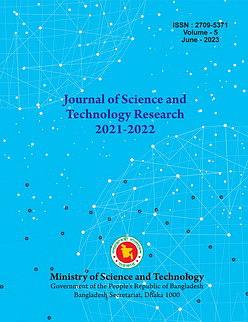Productivity and Profitability of Moringa-Brinjal-Based Agroforestry Farming System
DOI:
https://doi.org/10.3329/jscitr.v5i1.74000Keywords:
Drumstick, brinjal, growth parameters, yield, agroforestry.Abstract
An investigation was carried out to assess the productivity and profitability of brinjal during the initial phase of Moringa establishment. Experimental design employed a Randomized Complete Block Design with four distinct treatments: (i) T1 (30 cm distance from the tree base), (ii) T2 (40 cm distance from the tree base), (iii) T3 (50 cm distance from the tree base), and (iv) T4 (open field, control), each treatment being replicated four times. Data were systematically collected from randomly selected plants within each plot and subjected to statistical analysis. The findings indicated that the T4 (control) treatment exhibited superior performance for various parameters, namely plant height, leaf number, branch number, fruit number, fruit weight, and yield. Treatment T4 produced the highest values for fruit weight per plant (1.9 kg), single fruit weight (72.6 g), and fruit yield (34.2 t/ha). Following closely, T3 ranked second with values of 1.6 kg, 67.4 g, and 28.3 t for fruit weight per plant, single fruit weight, and fruit yield per hectare, respectively. In contrast, T1 yielded the lowest results in fruit weight per plant (0.76 kg), single fruit weight (59.6 g), and fruit yield (13.4 t/ha). The analysis of the land equivalent ratio revealed that treatment T3 achieved the highest ratio at 1.81, indicating a positive correlation between a greater distance from the Moringa tree base and an increased brinjal yield. The study concludes that cultivating brinjal in association with one-year-old Moringa trees, while maintaining a 50 cm distance from the tree base, results in optimal yield.
J. of Sci. and Tech. Res. 5(1): 09-20, 2023
166
250
Downloads
Published
How to Cite
Issue
Section
License
Copyright (c) 2023 Manoshi Roy

This work is licensed under a Creative Commons Attribution 4.0 International License.




